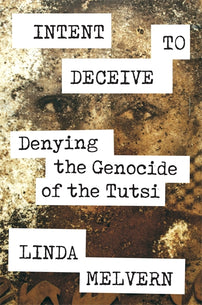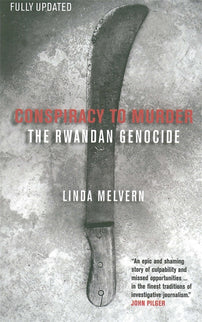The Money Man: the arrest of Felicien Kabuga
Linda Melvern, author of Intent to Deceive, on the arrest of Felicien Kabuga, one of leaders of the 1994 genocide of the Tutsi.

The arrest of Félicien Kabuga in a Paris suburb on May 16 is hardly a cause for celebration. A prime suspect for his involvement in the 1994 genocide of the Tutsi, Kabuga had been on the run for twenty-six years and is now an elderly man. One of the world’s most wanted fugitives there was a bounty of US $5 million under the US Awards for Justice program on his head. Somehow, he had managed to outwit everyone who searched for him including the international crime agency Interpol and undercover and specialised tracking teams with the International Criminal Tribunal for Rwanda (ICTR).
The failure for so many years to arrest Kabuga reflects badly on the ICTR, mandated in November 1994 by the Security Council to arrest and put on trial those who planned, financed, instigated, ordered, committed, or otherwise aided the crime. There are seven counts on the Kabuga charge sheet, file number ICTR-98-44B-1: complicity in genocide, direct and public incitement to commit genocide, attempt to commit genocide, conspiracy to commit genocide, persecution, and extermination. In an ICTR indictment dated April 2011 he is accused of having a central role in preparing a state policy of mass murder. He had helped to create a horrifyingly effective killing apparatus that had caused the deaths of more than one million people in the fastest murder rate of human beings recorded, the largest known child slaughter to date. The motive of the conspirators was to continue to monopolise power and enrich themselves, to continue to use the country as a personal fiefdom. As their crime got underway on Thursday April 7, 1994, they first eliminated the political opposition and murdered 10 peacekeepers hoping the UN Assistance Mission for Rwanda (UNAMIR) would cut and run as they tried to get rid of any troublesome outside interference.
The extraordinary delay in justice for such unspeakable crimes is forgotten today in the excited coverage of the arrest. It came in a dawn raid by French police officers on a third-floor middle-class apartment in a quiet Parisian suburb. Kabuga seems to have been relatively easy to find: an international effort with police teams from Belgium, France, and the UK had applied old-fashioned policing methods by keeping 24-hour surveillance on his children in France and Belgium and his daughter in south London. Noticing a pattern emerge of visits to an apartment in Paris rented by one of his children, the international police team homed in on his hideaway.
Immediate comparisons were made with the dramatic arrest in 1960 in Argentina of the Nazi fugitive Adolph Eichmann. There were predictions of a Kabuga trial in the Rwandan capital Kigali, comparable to that of Eichmann in Jerusalem in 1961. The Eichmann trial attracted world-wide press attention and exposed a new generation to the realities of the Holocaust in Europe and led to a better understanding of the nature of the crime of genocide. The comparisons are misplaced. Unlike Eichmann Kabuga was no cog in the wheel. While Eichmann carefully followed the instructions and plans of others, Kabuga had vision.
Nor is it likely we will see Kabuga in the dock any time soon. Justice may be too late and talk of a trial premature. The speed of events will largely depend on the International Residual Mechanism for Criminal Tribunals, known as the Mechanism, the successor body to the ICTR, created to finish the mandate set by the Security Council. Its chief prosecutor is Serge Brammertz and he believes the legal process necessary to transfer the prisoner from French into international custody might take weeks or months and it will be more than a year before a trial gets under way. It was Brammertz who has applied to a French court on behalf of the Mechanism for Kabuga’s transfer from a prison in Paris into international custody at The Hague. Brammertz thought the arrest of Kabuga a reason for rejoicing because so many had concluded Kabuga he would never be caught.
In his first court hearing in Paris five days after his arrest, Kabuga appeared in a wheelchair. His lawyers said their client’s age appearing in the court documents was in error and Kabuga, instead of 84 was aged 87. The lawyers said their client was frail and did not understand the charges levelled against him and they sought delays in the legal process. They wanted Kabuga released from prison given the risks of contamination with the Covid 19 during the medical pandemic. The lawyers said he needed medical and psychological tests. As he left the court, Kabuga raised a fist to the public benches where his relatives were sitting. He wanted his trial to take place in France, near his family.
The ICTR indictment from 2011 contains the outline of the prosecution case against Kabuga. A self-made entrepreneur, the richest man in the country, Kabuga provided crucial funding for the hate radio station Radio-Télévision Libre des Mille Collines (RTLM) that had mobilised the population, and broadcast incitement to violence and hatred. A powerful propaganda weapon, the radio broadcasts were designed to appeal to a largely illiterate and impoverished society, the broadcast of the racist ideology of Hutu Power integral to the crime and a causal factor in mass atrocities. In Rwanda, the connection between hate speech and atrocity was so strong that the hate media was considered a virtual laboratory for the development of atrocity speech law.
Kabuga’s indictment describes his “catalytic role” in the elimination of the political opposition starting on April 7 1994, that paved the way for the state policy of mass death to get underway; he was instrumental in the creation of the Interahamwe militia, the unemployed youth recruited from the streets, trained to kill at speed, and indoctrinated into the ideology of Hutu Power. Kabuga imported machetes from China, and widely distributed them to the militia, the tools needed for use in the killing.
The prosecution case against Kabuga in ICTR files includes statements from twelve anonymous witnesses, their depositions taken in May 2011 and sworn before an ICTR judge. The witnesses come from the heart of the Hutu Power movement and a Kabuga trial would shed light on one of the most mysterious and least understood aspect of this crime. Kabuga was the money man and the financial networks, and bank systems that he used, the easy transfers of money through accounts in the banks in New York, London, Brussels, and Paris, is yet to be explained, important in the planning phase and during months of killing in 1994.
Intent to Deceive has a description of the crime scene in July 1994 showing the documentary archives Hutu Power abandoned when its forces left the capital. While there were military lorries requisitioned to move thousands of files from the Ministry of Defence, documentary proof of their crime was found elsewhere. Not until August 1996 was a treasure trove of documents discovered in the vaults in the Banque Nationale du Rwanda (BNR) and here were details about how the genocide was prepared. The evidence was in invoices, bank statements, faxes, telexes, and ledgers, and in column after column of state expenditure. The bank documents revealed how finance was obtained to mould young delinquents, products of an impoverished society, and enrol them in their thousands in a civilian militia responsible for massacres and genocide. Every financial trick was used to fund the creation of the civilian youth militia and this included selling food stocks intended for famine relief. Some of the money for training and arming the militia came from loans granted to the regime in June 1991, from the International Development Association (IDA), the African Development Fund (AFD), the European Development Fund and bilateral donors including Austria, Switzerland, Germany, the United States, Belgium and Canada. Agreements had stipulated that funds must be used not for military or paramilitary purposes but for necessary goods such as food and equipment.
In the years to come, the Kabuga arrest will more than likely be judged as coming too late. The slow progress of international criminal justice will probably deprive the world of a Kabuga trial. And there are others still at large. In France, a group of genocide fugitives rely on the country as a haven and is noteworthy for the number and for the seniority of its members. After 1994, forty high-ranking alleged génocidaires were found to be working in France, living comfortable lives, and integrated into society. Of the forty Rwandan suspects identified, thirty-three cases are in the hands of French investigating magistrates and some pending for years. This has allowed Hutu Power a pernicious influence, its adherents able to spread rumour, stereotype, lies and propaganda to minimise their crime. These networks assist in spinning false narratives, spreading an alternative version of the genocide of the Tutsi, blaming the victims for their fate. The Hutu Power movement has tried to relativize he mass murder of Tutsi and calls the million dead a gigantic falsification of history. They use in exile the skills that had proved so useful during the genocide – propaganda and disinformation.
The idea Kabuga will plead guilty is fanciful. Like others in the movement he believes Hutu Power can be rehabilitated and that it can take its place once again in the political life of Rwanda and eventually people will understand its “achievements”. Kabuga is no Eichmann. He is not a cautious bureaucrat handing out money to fulfil the dreams of others but a key player.
Linda Melvern is a British investigative journalist. For twenty-five years she has research and written extensively about the circumstances of the 1994 genocide in Rwanda. A consultant to the Military One prosecution team at the International Criminal Tribunal for Rwanda, part of her archive of documents was used to show the planning, the financing and progress of the crime. She is the author of A People Betrayed: The Role of the West in Rwanda’s Genocide, Conspiracy to Murder and Intent to Deceive.
[book-strip index="1" style="display"]

